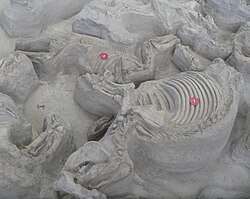| Cormohipparion | |
|---|---|

| |
| C. occidentale skeleton | |
| Scientific classification | |
| Domain: | Eukaryota |
| Kingdom: | Animalia |
| Phylum: | Chordata |
| Class: | Mammalia |
| Order: | Perissodactyla |
| Family: | Equidae |
| Subfamily: | Equinae |
| Tribe: | †Hipparionini |
| Genus: | †Cormohipparion Skinner & MacFadden, 1977 |
| Type species | |
| †Hipparion occidentale | |
| Subgenera and species | |
|
†Cormohipparion
†Notiocradohipparion
| |
Cormohipparion is an extinct genus of horse belonging to the tribe Hipparionini that lived in North America during the late Miocene to Pliocene (Hemphillian to Blancan in the NALMA classification).[1] They grew up to 3 feet (0.91 meters) long.[2][3]
Taxonomy
[edit]
The genus Cormohipparion was coined for the extinct hipparionin horse "Equus" occidentale, described by Joseph Leidy in 1856.[4] However it was soon argued that the partial material fell within the range of morphological variation seen in Hipparion, and that the members of Cormohipparion belonged instead within Hipparion.[5][6] This rested on claims that pre-orbital morphology did not have any taxonomic significance, a claim that detailed study of quarry sections later showed to be false.[7] The genus was originally identified by a closed off preorbital fossa, but later examinations of the cheek teeth, specifically the lower cheek teeth, of Cormohipparion specimens found that they were indeed valid and distinct from Hipparion.[8] A reappraisal of many horse genera was thus conducted in 1984,[9] and the proposed synonymy was not acknowledged by later literature.[10] C. ingenuum holds the distinction for being the first prehistoric horse to be described in Florida, as well as being one of the most common species of extinct species three-toed horses found to be in Florida.[11] Cormohipparion emsliei has the distinction of being the last hipparion horse known from the fossil record.[12]
The genus is considered to represent an ancestor to Hippotherium.[13] Its fossils have been recovered from as far south as Mexico.[14] Fossils have been found in the Great Plains and Rio Grande regions of North America, Mexico, Florida and Texas, which shows that they were herding animals.[15][16][17][18]
Evolution
[edit]
A species of Cormohipparion closely related to C. occidentale is thought to have crossed the Bering land Bridge over into Eurasia around 11.4-11 million years ago, becoming the ancestor to Old World hipparionines.[19]
References
[edit]- ^ MacFadden, Bruce J.; Skinner, Morris F. (1982). "Hipparion Horses and Modern Phylogenetic Interpretation: Comments on Forsten's View of Cormohipparion". Journal of Paleontology. 56 (6): 1336–1342. ISSN 0022-3360. JSTOR 1304670.
- ^ "Region 4: The Great Plains". geology.teacherfriendlyguide.org. Retrieved 2021-06-23.
- ^ Czaplewski, Nicholas J.; Thurmond, J. Peter; Wyckoff, Don G. (Fall 2001). "Wild Horse Creek #1: A Late Miocene (Clarendonian-Hemphillian) Vertebrate Fossil Assemblage in Roger Mills County, Oklahoma" (PDF). Oklahoma Geology. 61 (3): 60–67.
- ^ Skinner, M. F.; MacFadden, B. J. (1977). "Cormohipparion n. gen. (Mammalia, Equidae) from the North American Miocene (Barstovian-Clarendonian)". Journal of Paleontology. 51 (5). Paleontological Society: 912–926. JSTOR 1303763.
- ^ Forsten, A. (1982). "The Status of the Genus Cormohipparion Skinner and MacFadden (Mammalia, Equidae)". Journal of Paleontology. 56 (6). Paleontological Society: 1332–1335. JSTOR 1304669.
- ^ MacFadden, Bruce J. (1985). "Patterns of Phylogeny and Rates of Evolution in Fossil Horses: Hipparions from the Miocene and Pliocene of North America". Paleobiology. 11 (3): 245–257. Bibcode:1985Pbio...11..245M. doi:10.1017/S009483730001157X. ISSN 0094-8373. JSTOR 2400665. S2CID 89569817.
- ^ MacFadden, B. J.; Skinner, M. F. (1982). "Hipparion Horses and Modern Phylogenetic Interpretation_ Comments on Forsten's View of Cormohipparion". Journal of Paleontology. 56 (6). Paleontological Society: 1336–1342. JSTOR 1304670.
- ^ Forsten, Ann (1982). "The Status of the Genus Cormohipparion Skinner and MacFadden (Mammalia, Equidae)". Journal of Paleontology. 56 (6): 1332–1335. ISSN 0022-3360. JSTOR 1304669.
- ^ MacFadden, BJ (1984). "Systematics and phylogeny of Hipparion, Neohipparion, Nannippus, and Cormohipparion (Mammalia, Equidae) from the Miocene and Pliocene of the new world". American Museum of Natural History.
- ^ Hulbert Jr, R. C. (1988). "A New Cormohipparion (Mammalia, Equidae) from the Pliocene (Latest Hemphillian and Blancan) of Florida". Journal of Vertebrate Paleontology. 7 (4). The Society of Vertebrate Paleontology: 451–468. Bibcode:1988JVPal...7..451H. doi:10.1080/02724634.1988.10011675. JSTOR 4523166.
- ^ "Cormohipparion ingenuum". Florida Museum. 2017-03-30. Retrieved 2021-06-16.
- ^ "Neohipparion". Florida Museum. 2018-02-16. Retrieved 2021-06-26.
- ^ Woodburne, M. O. (2005). "A New Occurrence of Cormohipparion, with Implications for the Old World Hippotherium Datum". Journal of Vertebrate Paleontology. 25: 256–257. doi:10.1671/0272-4634(2005)025[0256:ANOOCW]2.0.CO;2. ISSN 0272-4634. S2CID 86241044.
- ^ Bravo-Cuevas, V. M.; Ferrusquía-Villafranca, I. (2008). "Cormohipparion (Mammalia, Perissodactyla, Equidae) from the Middle Miocene of Oaxaca, Southeastern Mexico". Journal of Vertebrate Paleontology. 28: 243–250. doi:10.1671/0272-4634(2008)28[243:CMPEFT]2.0.CO;2. ISSN 0272-4634. S2CID 131613568.
- ^ Skinner, Morris F.; MacFadden, Bruce J. (1977). "Cormohipparion n. gen. (Mammalia, Equidae) from the North American Miocene (Barstovian-Clarendonian)". Journal of Paleontology. 51 (5): 912–926. ISSN 0022-3360. JSTOR 1303763.
- ^ Bravo-Cuevas, Victor Manuel; Ferrusquía-Villafranca, Ismael (2008). "Cormohipparion (Mammalia, Perissodactyla, Equidae) from the Middle Miocene of Oaxaca, Southeastern Mexico". Journal of Vertebrate Paleontology. 28 (1): 243–250. doi:10.1671/0272-4634(2008)28[243:CMPEFT]2.0.CO;2. ISSN 0272-4634. JSTOR 30126348. S2CID 131613568.
- ^ Hulbert, Richard C. (1988). "A New Cormohipparion (Mammalia, Equidae) from the Pliocene (Latest Hemphillian and Blancan) of Florida". Journal of Vertebrate Paleontology. 7 (4): 451–468. Bibcode:1988JVPal...7..451H. doi:10.1080/02724634.1988.10011675. ISSN 0272-4634. JSTOR 4523166.
- ^ MacFadden, Bruce J.; Skinner, Morris F. (1981). "Earliest Holarctic Hipparion, Cormohipparion goorisi n. sp. (Mammalia, Equidae), from the Barstovian (Medial Miocene) Texas Gulf Coastal Plain". Journal of Paleontology. 55 (3): 619–627. ISSN 0022-3360. JSTOR 1304276.
- ^ Bernor, Raymond L.; Kaya, Ferhat; Kaakinen, Anu; Saarinen, Juha; Fortelius, Mikael (October 2021). "Old world hipparion evolution, biogeography, climatology and ecology". Earth-Science Reviews. 221: 103784. Bibcode:2021ESRv..22103784B. doi:10.1016/j.earscirev.2021.103784.








